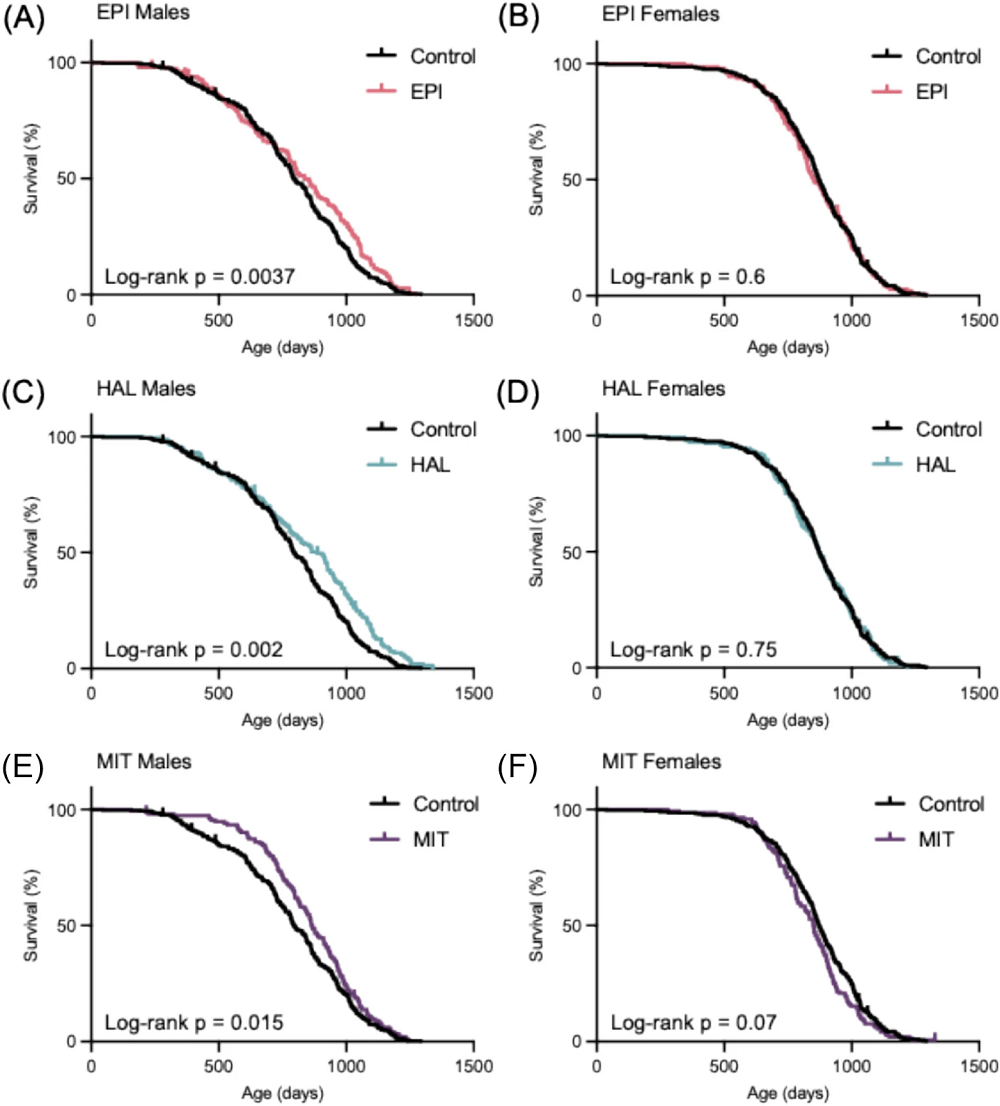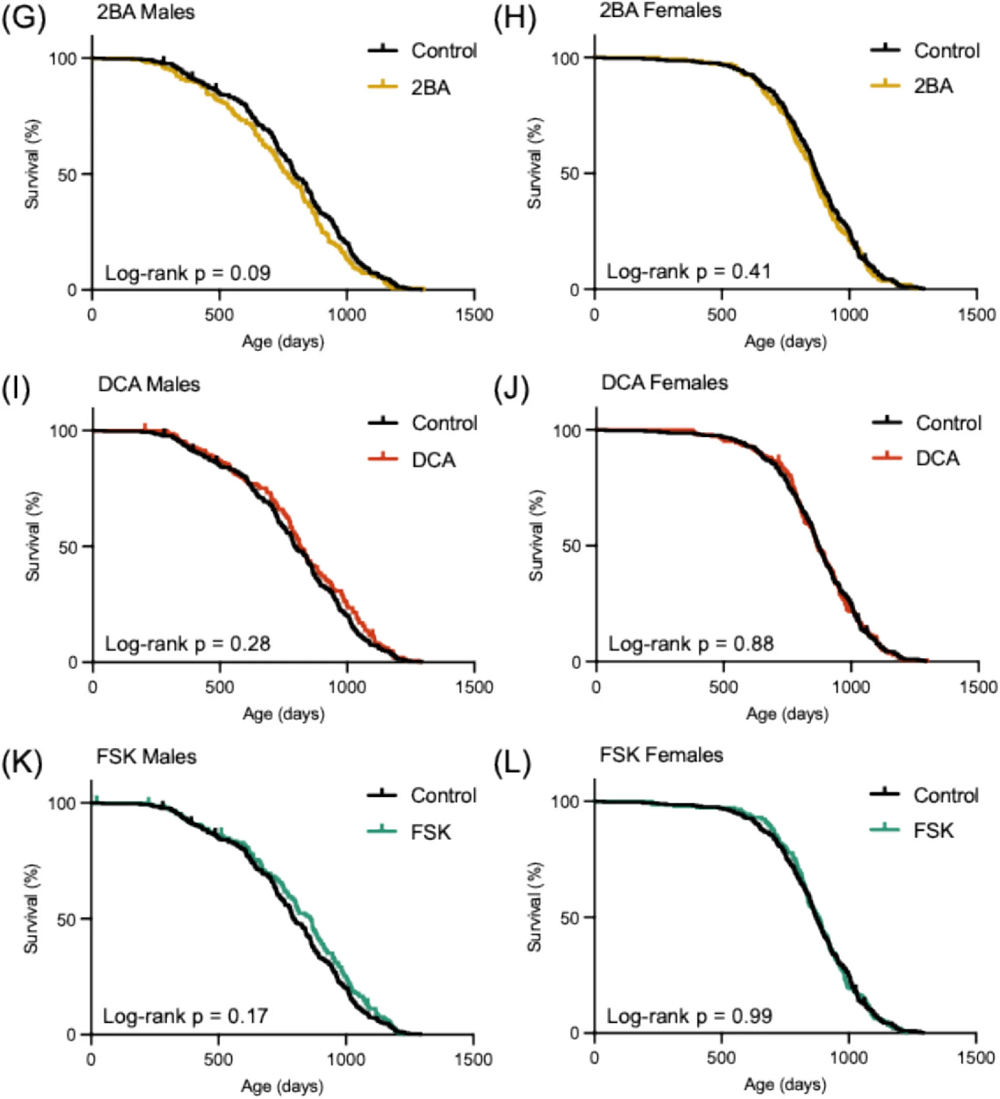A new report from the Interventions Testing Program adds three new compounds to the list of lifespan-extending compounds confirmed during their experiments: epicatechin, halofuginone, and mitoglitazone [1].
Rigorous testing
The National Institute on Aging’s Interventions Testing Program (ITP) is designed to rigorously test potential lifespan-extending compounds with a protocol that ensures reproducibility. In a standard investigation, one lab usually conducts lifespan experiments, but the ITP instead designs an experiment and performs it simultaneously at three locations: the Jackson Laboratory, the University of Michigan, and the University of Texas Health Science Center at San Antonio. If all labs obtain the same results while using the agreed protocol, it strengthens the evidence and its trustworthiness [2]. The ITP also uses genetically heterogeneous mice rather than a common inbred strain, increasing the generalizability of the results.
The researchers of this study tested 2BAct, dichloroacetate, epicatechin, forskolin, halofuginone, and mitoglitazone for their lifespan-extending properties. These compounds were selected based on previous studies demonstrating that they either extended lifespans in simple organisms or had anti-aging effects.
Extending lifespan
The researchers analyzed and presented the data in the standard, consistent way that ITP experiments are conducted. They analyzed pooled data from all three sites and each site separately for both males and females. Their statistical analysis included, among others, median lifespan and the lifespan of the top 10% (maximal lifespan), which reflects the “drug’s potential to support exceptionally long survival.”
Accordingly to the data pooled from all sites, among the compounds that showed a positive effect on lifespan, epicatechin, a flavanol found in cocoa, increased median lifespan by ~5% and maximal lifespan by ~6%. However, this effect was only observed in males, not females. Theis effect was statistically significant only for data polled from all sites. When the data were analyzed separately, male median lifespan showed a trend towards increased lifespan in all sites but didn’t reach statistical significance.
Even though the researchers did not test any mechanism for epicatechin, based on previous research on model organisms and humans, they hypothesize that it could increase lifespan by improving mitochondrial function and angiogenesis.
The data were similar for halofuginone, which, in males, increased the median lifespan by ~9% and maximal lifespan by ~7% but did not impact female lifespan according to the pooled data. When the data were analyzed separately for each site, both median lifespan and survival showed a trend towards an increase, but it reached significance in only one of the sites.
The researchers discuss two major properties that may be responsible for halofuginone’s positive impacts on lifespan and survival. First, halofuginone has been reported to have anti-inflammatory properties and so may ameliorate age-related inflammation. Second, it activated a response that possibly mimics amino acid restriction, which can increase lifespan. However, these explanations remain to be tested.
Mitoglitazone’s effect on survival was different from those of epicatechin and halofuginone. While it also increased the median lifespan in males by ~9% according to the pooled data, it did not affect 90% survival in either sex. Additionally, while there was no statistically significant effect on the median lifespan in females, the researchers observed a trend toward a slightly shortened lifespan.
Based on previous studies, the researchers suggest a few molecular mechanisms that could contribute to this lifespan extension, such as reprogramming of mitochondrial metabolism, reduction of inflammation, and androgen suppression.

Impacts on early and late life
Epicatechin and halofuginone shared more similarities. Neither of them affects survival until midlife: for both compounds, there is no difference in survival until the latter half of the lifespan curve, suggesting that they have higher efficacy in animals of advanced age. This observation is not common among the compounds tested by the ITP, as so far only canagloflozin and 17α-E2 have been identified as male-specific agents that increase 90% survival. These four compounds are the exception as, as the authors wrote, “most male-specific drugs tested by the ITP affect median survival but fail to increase 90% survival, a measure of late life efficacy.” Mitoglitazone is one such compound that fails to increase 90% survival, as mitoglitazone’s impact on survival in males declines with age.
The researchers suggest that the mechanism underlying lifespan extension must differ between mitoglitazone and the two other compounds. They suggest that mitoglitazone might work by delaying illnesses that are more common in younger animals, while epicatechin and halofuginone impact an organism in the later stages of lifespan. They suggest other studies to test the plasma levels of drugs as a function of age, suggesting that age might impact the metabolism of those drugs, resulting in low mitoglitazone levels in later stages of life, while epicatechin and halofuginone levels increase.
Optimizing for increased survival
The remaining three tested compounds, 2BAct, dichloroacetate, and forskolin, didn’t show a statistically significant impact on the lifespan of either males or females. However, forskolin has demonstrated a trend toward increased median survival in males. While this result was not statistically significant, it suggests potential, and the authors advise that it would be wise to test different forskolin doses, as they might provide better results. Testing different doses for the compounds that have shown an increase in survival is also advisable, since these compounds have shown only a modest effect. Dose optimization might lead to more profound effects on survival.

Male-specific improvements
The study authors note that epicatechin, halofuginone, and mitoglitazone fall into a trend observed in the ITP program. During the two decades of testing different compounds, more compounds have been reported to have higher efficacy or be only efficacious in males. Specifically, among the 14 compounds shown to increase lifespan by the ITP researchers, eight have sex-specific effects and increase lifespan in males (astaxanthin, NDGA, 17a-estradiol, meclizine, protandim, epicatechin, halofuginone, and mitoglitazone) but not in females, and none of these agents extended only female lifespan.
This research adds to the growing evidence of the importance of sex-specific differences in aging research and the importance of including female subjects in the study (which was not a common practice in the past), as the results clearly show that male data doesn’t always translate to females. What’s more, some compounds might have the opposite effect. The authors also discuss that while the ITP program doesn’t focus on investigating the mechanisms behind the lifespan extension effects of its tested compounds, future research should explore them, including the reasons behind sex-dependent differences.
Literature
[1] Strong, R., Nelson, J. F., Bogue, M. A., Colca, J. R., Denzel, M., Diaz, V., Finck, B. N., Gladyshev, V. N., Horvath, S., Jiang, N., Keller, T., Kletzien, R. F., Korstanje, R., Kumar, N., Leeuwenburgh, C., Fernandez, E., Galecki, A., Ginsburg, B., Han, M., Kaczorowski, C., … Harrison, D. E. (2025). Extension of lifespan by epicatechin, halofuginone and mitoglitazone in male but not female genetically heterogeneous mice. GeroScience, 10.1007/s11357-025-01881-6. Advance online publication.
[2] Nadon, N. L., Strong, R., Miller, R. A., Nelson, J., Javors, M., Sharp, Z. D., Peralba, J. M., & Harrison, D. E. (2008). Design of aging intervention studies: the NIA interventions testing program. Age (Dordrecht, Netherlands), 30(4), 187–199.
View the article at lifespan.io








































